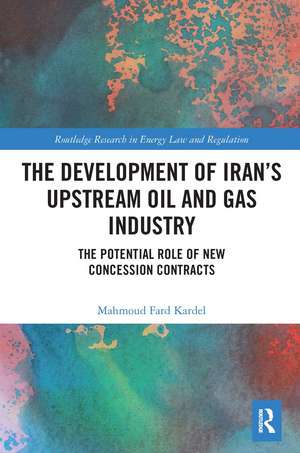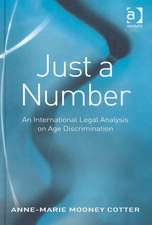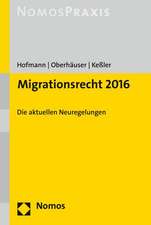The Development of Iran’s Upstream Oil and Gas Industry: The Potential Role of New Concession Contracts: Routledge Research in Energy Law and Regulation
Autor Mahmoud Fard Kardelen Limba Engleză Paperback – 13 dec 2021
| Toate formatele și edițiile | Preț | Express |
|---|---|---|
| Paperback (1) | 383.30 lei 43-57 zile | |
| Taylor & Francis – 13 dec 2021 | 383.30 lei 43-57 zile | |
| Hardback (1) | 1000.27 lei 43-57 zile | |
| Taylor & Francis – 19 sep 2019 | 1000.27 lei 43-57 zile |
Preț: 383.30 lei
Nou
Puncte Express: 575
Preț estimativ în valută:
73.34€ • 76.78$ • 60.69£
73.34€ • 76.78$ • 60.69£
Carte tipărită la comandă
Livrare economică 07-21 aprilie
Preluare comenzi: 021 569.72.76
Specificații
ISBN-13: 9781032240398
ISBN-10: 1032240393
Pagini: 210
Dimensiuni: 156 x 234 x 11 mm
Greutate: 0.3 kg
Ediția:1
Editura: Taylor & Francis
Colecția Routledge
Seria Routledge Research in Energy Law and Regulation
Locul publicării:Oxford, United Kingdom
ISBN-10: 1032240393
Pagini: 210
Dimensiuni: 156 x 234 x 11 mm
Greutate: 0.3 kg
Ediția:1
Editura: Taylor & Francis
Colecția Routledge
Seria Routledge Research in Energy Law and Regulation
Locul publicării:Oxford, United Kingdom
Public țintă
PostgraduateNotă biografică
Dr Mahmoud Fard Kardel has a PhD in law from Western Sydney University in Australia (2018). Kardel has published las titles in international journals in Europe, Australia, Asia and Iran. Dr Kardel has practiced law in Tehran (2007) and is due to take on an academic position as an Assistant Professor of Law at Shahid Beheshti University (National University of Iran) in July 2020.
Cuprins
Table of Contents
Abstract
List of Selected Acronyms
Key Definitions
Acknowledgements
CHAPTER 1: INTRODUCTION
1.1 Classic concession contract
1.2 New concession contract
1.3 Need for Iran to transition to NCC
1.4 Main question
1.5 Background of Iran’s oil and gas contracts
1.5.1 Pre-nationalisation period (1901-1951)
1.5.2 Hybrid period (1951-1979)
1.5.3 Contemporary period (1979-2018)
1.6 Overview of Iran’s oil and gas legal development
1.7 Methodology
1.8 Book structure
1.9 Conclusion
CHAPTER 2: HISTORY AND LEGAL FRAMEWORK OF IRAN’S OIL AND GAS CONTRACTS AND SECTORS OF OIL AND GAS INDUSTRY
2.1 Oil and gas industry of Iran
2.1.1 The upstream sector
2.1.2 The downstream sector
2.2 History and legal frameworks of Iran’s oil and gas
2.2.1 From exploration to nationalisation (1901-1951)
2.2.2 From nationalisation to revolution (1951-1979)
2.2.3 From 1979 Islamic Republic of Iran’s revolution to the present day
2.3 Legal and comparative analysis
2.3.1 Ownership
2.3.2 Duration
2.3.2 Income
2.4 Conclusion:
CHAPTER 3: THE NATURE AND FEATURES OF CLASSIC AND NEW OIL AND GAS CONCESSION CONTRACTS
3.1 Definition of concession agreement
3.2 Classic concession contracts
3.2.1 Definition
3.2.2 The legal nature of oil and gas concession contracts
3.2.3 Features
3.3 New concession contracts
3.3.1 Features
3.4 Distinguishing between the classic concession and the new concession contract
3.4.1 Party
3.4.2 Method of awarding
3.4.3 Area of concession
3.4.4 Duration
3.4.5 Ownership
3.4.6 Government revenue
3.4.7 Taxation
3.4.8 Participation
3.4.9 Control
3.4.10 Renegotiation
3.4.11 Settlement of dispute
3.5 Conclusion
CHAPTER 4: NEW CONCESSION CONTRACT: NATIONAL FRAMEWORK
4.1 Brazil
4.1.1 Brazilian rounds: granting of exploration and production rights
4.1.2 Main contractual terms
4.2 Thailand
4.2.1 Parties to the contract
4.2.2 Reserve ownership in Thailand
4.2.3 Main contractual terms
4.3 Australia
4.3.1 Ownership and accessibility
4.3.2 Licence and modern licensing regime
4.3.3 Australian modern licensing regime
4.4 United Kingdom
4.4.1 Licensing system
4.4.2 Features
4.5 Norway
4.5.1 Licensing regime
4.5.2 Licensing system in Norway
4.6 Conclusion
CHAPTER 5: CURRENT OIL AND GAS CONTRACT FRAMEWORK IN THE WORLD AND COMPARISONS BETWEEN THEM
5.1 Production Sharing Agreement (PSA)
5.1.1 Definition
5.1.2 Legal nature
5.1.3 Structure
5.1.4 Main terms and features
5.2 Joint venture (JV)
5.2.1 Legal nature
5.2.2 Main terms
5.3 Service contract
5.3.1 Legal nature
5.4 Iranian buy-back contract
5.4.1 Definition
5.4.2 Why and how Iran acceded to buy-back
5.4.3 Buy-back generations
5.4.4 Main terms of IPC
5.4.5 Critical analysis of IPC
5.4.6 Features of buy-back
5.4.7 Result and analysis criticism
5.5 Criteria for evaluating and comparison between oil and gas contractual framework
5.5.1 Objective
5.5.2 Ownership
5.5.3 Management
5.5.4 Cost and risk
5.5.5 Government revenue
5.6 The NCC positive and negative points compared with other oil and gas contract form
5.6.1 Objective
5.6.2 Ownership
5.6.3 Management
5.6.4 Cost and risk take
5.6.5 Government revenue
5.7 Conclusion
CHAPTER 6: DISCUSSION OF THE CHALLENGES IN PROPOSAL A NEW CONCESSION CONTRACT FOR IRAN’S OIL AND GAS INDUSTRY
6.1 Islamic (Sharia) law
6.1.1 Sources of Islamic law
6.1.2 Islamic denominations
6.1.3 Islamic Jurisprudence and Its major schools
6.1.4 Shi’a perspective on natural resources
6.2 Oil and gas legal framework in Iran
6.2.1 Constitution
6.2.2 Petroleum Act 1987
6.2.3 Foreign Investment Promotion and Protection Act (FIPPA)
6.2.4 Five-year economic, social and cultural development plans
6.2.5 The Act to Modify Petroleum Act (1987) of 2011
6.2.6 The Duty and Authorities of Oil Ministry Act (2012)
6.3 Challenges of adopting New Concession Contract in Iran
6.3.1 Opportunities
6.3.2 Barriers
6.4 Efficiency of New Concession Contract in Iran’s oil and gas industry
6.5 Modernising Iran’s oil and gas contract framework and regulation
6.5.1 Modernising Iran’s oil and gas contract framework
6.5.2 Modernising Iran’s oil and gas regulation
6.6 Proposing new concession contract (NCC) Framework
6.6.1 Ownership of oil and gas in NCC
6.6.2 Control and management over oil operations
6.6.3 Financial Regime in NCC
6.6.4 Build-Operate-Transfer (BOT)
6.6.5 Leasing and license
6.7 Conclusion
CHAPTER 7: CONCLUSION
7.1 Financial issue
7.2 Geological factors
7.3 Challenging the Status Quo
7.4 Future proposals of NCC
Bibliography
Abstract
List of Selected Acronyms
Key Definitions
Acknowledgements
CHAPTER 1: INTRODUCTION
1.1 Classic concession contract
1.2 New concession contract
1.3 Need for Iran to transition to NCC
1.4 Main question
1.5 Background of Iran’s oil and gas contracts
1.5.1 Pre-nationalisation period (1901-1951)
1.5.2 Hybrid period (1951-1979)
1.5.3 Contemporary period (1979-2018)
1.6 Overview of Iran’s oil and gas legal development
1.7 Methodology
1.8 Book structure
1.9 Conclusion
CHAPTER 2: HISTORY AND LEGAL FRAMEWORK OF IRAN’S OIL AND GAS CONTRACTS AND SECTORS OF OIL AND GAS INDUSTRY
2.1 Oil and gas industry of Iran
2.1.1 The upstream sector
2.1.2 The downstream sector
2.2 History and legal frameworks of Iran’s oil and gas
2.2.1 From exploration to nationalisation (1901-1951)
2.2.2 From nationalisation to revolution (1951-1979)
2.2.3 From 1979 Islamic Republic of Iran’s revolution to the present day
2.3 Legal and comparative analysis
2.3.1 Ownership
2.3.2 Duration
2.3.2 Income
2.4 Conclusion:
CHAPTER 3: THE NATURE AND FEATURES OF CLASSIC AND NEW OIL AND GAS CONCESSION CONTRACTS
3.1 Definition of concession agreement
3.2 Classic concession contracts
3.2.1 Definition
3.2.2 The legal nature of oil and gas concession contracts
3.2.3 Features
3.3 New concession contracts
3.3.1 Features
3.4 Distinguishing between the classic concession and the new concession contract
3.4.1 Party
3.4.2 Method of awarding
3.4.3 Area of concession
3.4.4 Duration
3.4.5 Ownership
3.4.6 Government revenue
3.4.7 Taxation
3.4.8 Participation
3.4.9 Control
3.4.10 Renegotiation
3.4.11 Settlement of dispute
3.5 Conclusion
CHAPTER 4: NEW CONCESSION CONTRACT: NATIONAL FRAMEWORK
4.1 Brazil
4.1.1 Brazilian rounds: granting of exploration and production rights
4.1.2 Main contractual terms
4.2 Thailand
4.2.1 Parties to the contract
4.2.2 Reserve ownership in Thailand
4.2.3 Main contractual terms
4.3 Australia
4.3.1 Ownership and accessibility
4.3.2 Licence and modern licensing regime
4.3.3 Australian modern licensing regime
4.4 United Kingdom
4.4.1 Licensing system
4.4.2 Features
4.5 Norway
4.5.1 Licensing regime
4.5.2 Licensing system in Norway
4.6 Conclusion
CHAPTER 5: CURRENT OIL AND GAS CONTRACT FRAMEWORK IN THE WORLD AND COMPARISONS BETWEEN THEM
5.1 Production Sharing Agreement (PSA)
5.1.1 Definition
5.1.2 Legal nature
5.1.3 Structure
5.1.4 Main terms and features
5.2 Joint venture (JV)
5.2.1 Legal nature
5.2.2 Main terms
5.3 Service contract
5.3.1 Legal nature
5.4 Iranian buy-back contract
5.4.1 Definition
5.4.2 Why and how Iran acceded to buy-back
5.4.3 Buy-back generations
5.4.4 Main terms of IPC
5.4.5 Critical analysis of IPC
5.4.6 Features of buy-back
5.4.7 Result and analysis criticism
5.5 Criteria for evaluating and comparison between oil and gas contractual framework
5.5.1 Objective
5.5.2 Ownership
5.5.3 Management
5.5.4 Cost and risk
5.5.5 Government revenue
5.6 The NCC positive and negative points compared with other oil and gas contract form
5.6.1 Objective
5.6.2 Ownership
5.6.3 Management
5.6.4 Cost and risk take
5.6.5 Government revenue
5.7 Conclusion
CHAPTER 6: DISCUSSION OF THE CHALLENGES IN PROPOSAL A NEW CONCESSION CONTRACT FOR IRAN’S OIL AND GAS INDUSTRY
6.1 Islamic (Sharia) law
6.1.1 Sources of Islamic law
6.1.2 Islamic denominations
6.1.3 Islamic Jurisprudence and Its major schools
6.1.4 Shi’a perspective on natural resources
6.2 Oil and gas legal framework in Iran
6.2.1 Constitution
6.2.2 Petroleum Act 1987
6.2.3 Foreign Investment Promotion and Protection Act (FIPPA)
6.2.4 Five-year economic, social and cultural development plans
6.2.5 The Act to Modify Petroleum Act (1987) of 2011
6.2.6 The Duty and Authorities of Oil Ministry Act (2012)
6.3 Challenges of adopting New Concession Contract in Iran
6.3.1 Opportunities
6.3.2 Barriers
6.4 Efficiency of New Concession Contract in Iran’s oil and gas industry
6.5 Modernising Iran’s oil and gas contract framework and regulation
6.5.1 Modernising Iran’s oil and gas contract framework
6.5.2 Modernising Iran’s oil and gas regulation
6.6 Proposing new concession contract (NCC) Framework
6.6.1 Ownership of oil and gas in NCC
6.6.2 Control and management over oil operations
6.6.3 Financial Regime in NCC
6.6.4 Build-Operate-Transfer (BOT)
6.6.5 Leasing and license
6.7 Conclusion
CHAPTER 7: CONCLUSION
7.1 Financial issue
7.2 Geological factors
7.3 Challenging the Status Quo
7.4 Future proposals of NCC
Bibliography
Descriere
This book critically examines different forms of petroleum contracts, the historical perspective of oil and gas industry and the political economy of the petroleum development in Iran.




























